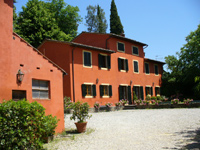As we were on our walking tour of Lucca, we were surprised to see two bands marching. Was this something Nina had scheduled for us?


Photos by Mike and Bernice Lincicum
This is San Michele, with its Pisan Romanesque facade.
This was one of the entrances to an oval enclosed area which had at one time been a Roman arena. When it was demolished it was replaced by huts and the larger buildings were built around it. Later the huts were also demolished and the area in the middle remained and is now used for shops and restaurants.
Lucca's most remarkable feature is its Renaissance wall. During the course of history, there were three sets of walls around Lucca, Etruscan, Roman (now almost completely missing) and Renaissance.
Photo by Don and Arlene Hover.
This is one of six gates into the city.
Photo by Don and Arlene Hover.
The wall around the city is good for biking. Most of the people on our tour rode bikes.
Photos by Mike and Bernice Lincicum
A few walked the 2.5 miles around the city.
We were all tired and rested a while before taking the bus at about 7:30 to a restaurant Nina had chosen. It was a typical Italian dinner in that we had a number of courses with long waits between. We were served 3 or 4 crostinis, with spelt and chicken as the first plate, a soup course, a pasta course, then the second plate of beef with veggies and beans. The dessert was Vin Santo, a local wine in which to dip biscotti. The meal was very good but we didn't finish until 11:15.
Nina scheduled a later start in the morning as we took the bus to visit two villas. We first saw the Villa Oliva.
Although we were not allowed to take photos in the rest of the villa, we could do so in the kitchen.
This is the rear of the villa with its loggia.
This is the Lemon House where the potted lemons are stored in the winter. In the summer it can be used for special occasions.
This is the interior of the Lemon House with a ficus growing inside. There is only one plant, rooted behind the first pillar.
Photo by Don and Arlene Hover.
This is the Villa Grabau, the second villa we visited.
This is now the home of Anna Dora Anfuso, the original owner of the larger villa that is now owned by her son.
She was a delightful woman who invited us to see the home. She also entertained us with her conversation and tea and water and goodies.
Photo by Don and Arlene Hover.
Nina arranged for us to have lunch in a building that had originally been used to press olives.
Photo by Don and Arlene Hover.
This was the menu our local guide had prepared for us.
We had the afternoon free and some of us visited churches in the city. First we saw San Frediano, which was rather bare inside but had wonderful mosaic on its exterior.
One of the more interesting churches was the 12th century San Giovanni church where one can visit the archaeological excavations beneath the floor. The photo is of the remains of a 1st century Roman bath.
This mosaic was of the 4th or 5th century.
This is what remains of a baptistry of the 12th century. Some tour members came to this church later in the evening for a Mozart concert.
One more church-this is the San Martino Cathedral, begun in the 11th century.
This is a closeup of the interesting mix of architectural and artistic styles of the church. In the larger version of this photo you can see the variety of columns in the facade as well as the statue of St. Martin as he gives his coat to a poor man.
Tomorrow we are scheduled to see the marble quarries of Carrara on our way to Levanto and the Cinque Terra.
























